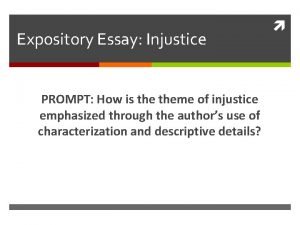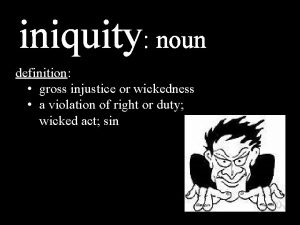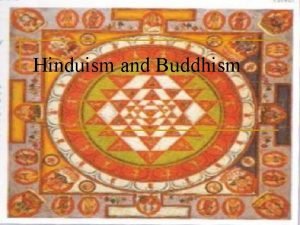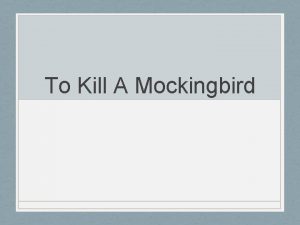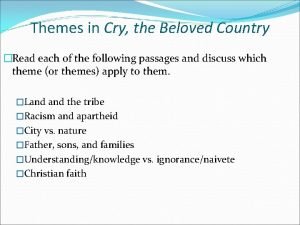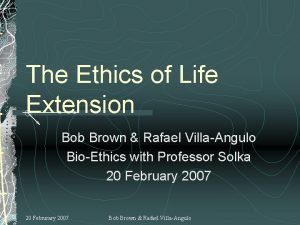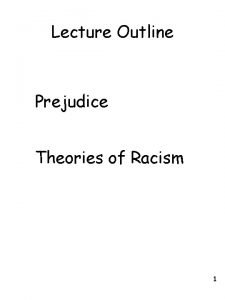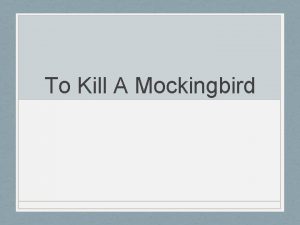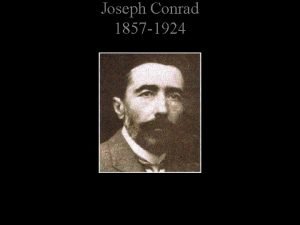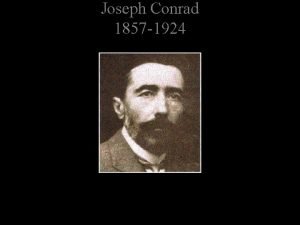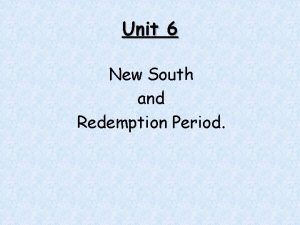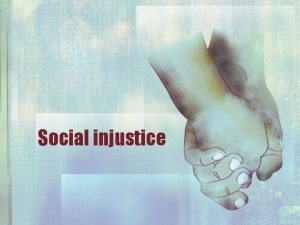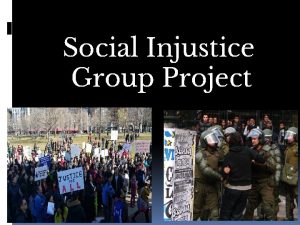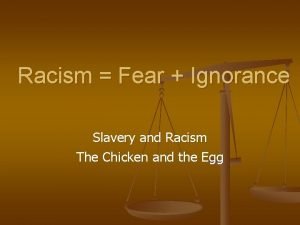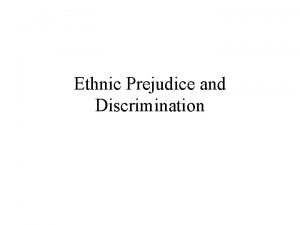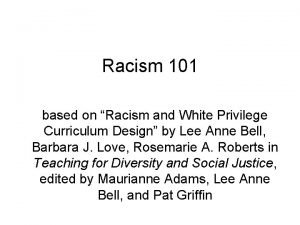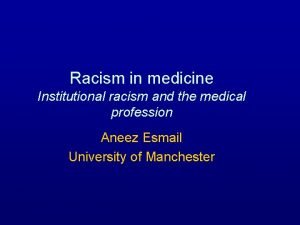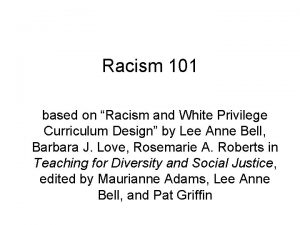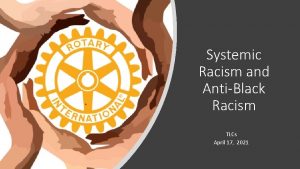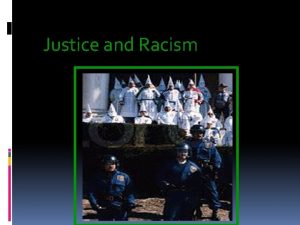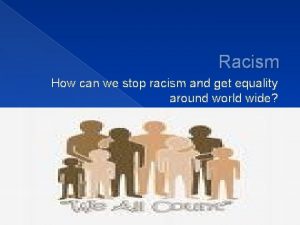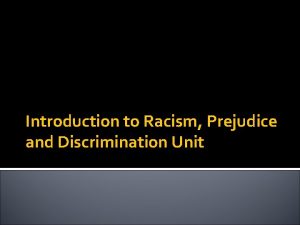RACISM AND INJUSTICE IN THE NEW SOUTH Failure





































































- Slides: 69

RACISM AND INJUSTICE IN THE NEW SOUTH

Failure of the New South One of the failures of the New South Era was that it was a time of terrible racism and injustice. The social and political gains made by African-Americans during the 1870 s and 1880 s began to be chipped away by white politicians in the 1890 s. Laws called Jim Crow Laws, named after a fictional character, took away most of the citizenship rights of African-Americans.

Jim Crow Laws Defined Jim Crow laws were state and local laws passed from the end of Reconstruction in 1877 through the mid-1950 s by which white southerners reasserted their dominance by denying African Americans basic social, economic, and civil rights.

What Jim Crow Law stood out to you?

Jim Crow Laws Under these laws almost every aspect of life was segregated. This included separate schools, sections of public transportation, water fountains, bathrooms, and even separate grave yards and Bibles used to swear on in courts.

Plessy v Ferguson On June 7, 1892, Homer Plessy was arrested in Louisiana for sitting in the “Whites Only” section of a railcar. In this planned protest, Plessy, who was 1/8 th black and “could pass for white” identified himself as a black man. This orchestrated event was planned by the “Committee of Citizens, ” a group of well educated African-Americans who wanted to test Louisiana’s segregation laws.

Plessy v Ferguson The case went all the way to the Supreme Court, where the court ruled in favor of Louisiana, based on the “separate but equal” doctrine. The court determined that under the Constitution (14 th and 15 th Amendments) blacks had political rights, but social rights were not required. According to the court, as long as facilities were equal for both races they could be separate.

Plessy v Ferguson Upon this ruling most southern states, including Georgia, separated all aspects of life. This included separate theaters and movie houses, rail and street cars, and separate bathrooms. Though separate, these facilities were most certainly not equal. For example, the average white school in the state spent about $43 dollars per student in 1930, in comparison to $10 per student in all black schools

Jim Crow and Voting The 14 th and 15 th amendments to the U. S. Constitution, which guaranteed citizenship rights to all African-Americans and voting rights to African. American men, were ratified by the U. S. Congress and included the votes of the Southern states. However, during the Jim Crow era, most blacks in the South lost these voting rights. Due to the lack of enforcement by the federal government, the southern states, including Georgia, established many laws that prevented blacks, and poor whites for that matter, from voting. This was known as…

Disenfranchisement To deprive of a legal right, or of some privilege; especially : to deprive of the right to vote

Poll Taxes (1877) Voters had to pay a tax to vote. Most poor blacks and many poor whites could not pay this tax and were unable to vote. In some cases the poll was waived for poor whites.

The White Primary (1900) The White Primary did not allow African. Americans to vote in the primary elections. Due to the fact that the dominate party in the Georgia was the Democratic Party, most of the major decisions took place during the primary election.

Literacy Tests (1908) You had to pass a literacy test to vote. Intended to prevent African. Americans from voting. Due to the substandard education in the South for both poor blacks and whites, many Georgians could not read or write and could not pass these tests in order to vote. Some whites were “passed” by polling officials to allow them to vote, though others were not. However, many educated blacks were told that they still failed the test and were unable to vote.

The Grandfather Clause (1890 -1910) These laws usually said that if a person’s grandfather or father was able to vote before the Civil War then they could too, without paying a poll tax or taking a literacy test. Used to allow some poor white citizens the opportunity to vote while continuing to deny the right to blacks.

The County Unit System The county unit system was established in 1917 when the Georgia legislature, overwhelmingly dominated by the Democratic Party, passed the Neill Primary Act. The system allotted votes by county. All 159 counties were classified according to population into one of three categories: urban, town, or rural. Urban counties were the 8 most populous; town counties were the next 30 in population size; and rural counties were made up of the remaining 121.

The County Unit System Based upon this classification, each county received unit votes in statewide primaries. The urban counties received six unit votes each, the town counties received four unit votes each, and the rural counties received two unit votes each.

The County Unit System County Number of Unit Votes Urban Town Rural (8 Counties) (30 Counties) (121 Counties) 6 each 4 each Voting Scenario Task 2 each

County Unit System For example, the state's three least populous counties, Echols, Glascock, and Quitman, had a combined population of 6, 980, while Fulton County, the most populous, had a population of 556, 326. Collectively, the three smallest counties had a unit vote that equaled the unit vote of Fulton. Eugene Talmadge's 1946 primary victory was due to the Unit system. Talmadge lost to James V. Carmichael by 16, 000 votes but won the election since he received 244 county unit votes, as opposed to 144 for Carmichael.

The County Unit System The significance of this system was that the rural counties enjoyed a control of statewide elections that was out of proportion to their size. The rural counties accounted for only 32 percent of the state population, but they controlled 59 percent of the total unit vote. As a result, rural votes served to protect such policies as legal segregation and other aspects of white supremacy by diluting the influence of more liberal urban voters and of blacks, who were concentrated in Georgia cities.

Atlanta Race Riot Atlanta has traditionally been viewed as a progressive southern city, whose relatively tolerant racial policies allowed for the rise of many successful African-American social leaders, institutions of higher education, and businesses. However, one tragic event in Atlanta’s history tarnishes this reputation.

Task The immediate spark for this event was a series of local newspaper articles. Read the headlines from the newspapers leading up to the event. What do the headlines suggest?


The Atlanta Race Riot The immediate spark for this 48 -hour riot (September 22 -24) was a series of local newspaper articles alleging African-American male attacks on white women. The problem is that these articles proved to be untrue.

Cause of the Race Riot As with most historical events, there were many underlying causes of the riot…

Unemployment One underlying cause of the Atlanta Race Riot was the large number of unemployed and frustrated whites who viewed African-American as threats to jobs and the established social order. By the 1880 s Atlanta had become the hub of the regional economy, and the city's overall population soared from 89, 000 in 1900 to 150, 000 in 1910; the black population was approximately 9, 000 in 1880 and 35, 000 by 1900. This growth increased job competition among black and white workers It led to an expansion of Jim Crow segregation, particularly in the separation of white and black neighborhoods and separate seating areas for public transportation.

Successful African Americans Whites were also jealous of successful African. American business leaders who used their business success to create social networks and build communities.

Georgia Governors Race The two candidates for governor, Hoke Smith (former publisher of the Atlanta Journal) and Clark Howell (editor of the Atlanta Constitution), fueled the racial fires as they based their campaigns on the platform of white supremacy. Both men influenced public opinion through their newspapers.

Hoke Smith Inflamed racial tensions in Atlanta by insisting that black disenfranchisement was necessary to ensure that blacks were kept "in their place. ” � Smith argued that since African Americans had received the right to vote, that they had sought economic and social equality. �

� Clark Howell Claimed that the Democratic white primary and the poll tax were already sufficient in limiting black voting. � Instead, Howell emphasized that Smith was not the racial separatist he claimed to be, and he charged that Smith had in the past cooperated with black political leaders and could not be relied upon to advance the cause of white supremacy.

Smith won the election

The Riot On the morning of the riot, there were four articles published about assaults on white women. A group of mostly unemployed white men and boys gathered in downtown seeking revenge for the false attacks. Though city officials tried to calm the mob, the group of men began attacking any black that they saw.

The Riot Travelling into the black business district the mob killed two barbers and beat several men to death on street cars. Due to the violence, Georgia was put under martial law and the Georgia militia was called into the city. African-Americans began to arm themselves and in some cases fought off their attackers.

Casualties of the Riot The riot lasted two days. Estimates range from twenty-five to forty African American deaths, although the city coroner issued only ten death certificates for black victims. Most accounts agree that only two whites were killed, one of whom was a woman who suffered a heart attack on seeing the mob outside her home.

The Riot The riot caused unwanted negative national and international attention for the “jewel of the New South. ” Atlanta business leaders, both black and white, quickly came together to end the riot and restore order. Though this bi-racial committee was historic in itself, as a groups such as this had rarely met in the South, the end result led to deeper segregation in the city

Task Read the headlines on the following page. What does it suggest the next case is about? Make a prediction about what you think happened?


The Leo Frank Case On April 26, 1913, Mary Phagan went to the pencil factory to collect her $1. 20 pay check for a 12 hour work week. Phagan received her pay from her supervisor, Leo Frank, and then left. She never returned home and, later that evening, her beaten body was found in the basement of the factory. When newspaper reports were released that suggested that she had also been sexually assaulted, the public demanded justice.

The Suspects Jim Conley Leo Frank Superintendent of factory Janitor of factory Newt Lee Night watchmen of factory

Newt Lee discovers Mary Phagan’s body at approximately 3: 15 a. m. when he was doing his rounds. He attempts to call Frank, but is unable to reach him. He then calls the police. Lee is arrested on suspicion of murder. He is later released and provides testimony against Frank.

The Leo Frank Case. Evidence When police took Frank from his house the next morning, he appeared nervous. He went with them to see Phagan's body in the factory. Frank claimed to have been in his office for about twenty minutes or more after Phagan left the previous day. Another young factory worker who had come shortly afterward to collect her pay stated that Frank was not in sight when she arrived. She waited a few minutes and then left.

The Leo Frank Case. Evidence Newt Lee told police that he tried to come to work at 4: 00, but was told by Frank to come back 2 hours later. Lee said that he asked to sleep in the packing room, but was told no and to leave the factory until 6. Lee also told police that Frank called later in the day to see if everything was all right, which he had never done before.

The Leo Frank Case. Evidence Nina Formby, the owner of a "rooming house, " stating that Frank had made repeated calls to her on the day of the murder attempting to reserve a room for himself and a girl. A young friend of Mary's, George Epps, said that Mary said that Frank had made advances towards her. Several other employees at the factory also claimed they had seen Frank flirt with various females at the plant.

The Leo Frank Case. Evidence Jim Conley, a black janitor, was also arrested when he was seen washing red stains from a shirt. Two notes were found near the body. One seemed to identify the murderer ("a long tall negro black that hoo it wase"), while the other suggested that the writer was told by the actual murderer to throw suspicion elsewhere ("he said he would love me. . . play like the night witch did it but that long tall black negro did buy his slef. ") Jim Conley said that he wrote one and that Leo Frank wrote the other. Both matched the handwriting of Jim Conley. He later admits that he wrote both, but was instructed to do so by Leo Frank. Jim Conley gave four contradictory statements explaining how he had helped Frank dispose of the body.

Task Based on the evidence respond to the following… 1. Who do you think committed the murder? 2. Who do you think will be convicted of the murder?


The Trial As the July 28 date for the opening of the Frank trial approached, the procecution worked with Conley to turn him into the most effective possible prosecution witness. The men smoothed and refined the content of the sweeper’s testimony, as well as educated him on the importance of maintaining eye contact with the jury and other fine points of polished delivery.

The Trial Fannie Coleman, the mother of Mary, testified as the prosecution's first witness. The witness hid tears behind a large palm-leaf fan as she identified the blood-stained clothes worn by Mary on the day she last saw her. Fifteen-year-old George Epps was next. Epps testified that on the day of the murder he rode the streetcar with Mary to a stop near the pencil factory, where she disembarked at 12: 07.

The Trial Newt Lee provided the most important testimony of the trial’s opening day. Lee testified that at 7: 00 p. m. on the evening of the murder he received a call from Frank (something that had never happened before) asking if things were okay at the plant.

The Trial The prosecution got officers to describe where Frank might have obtained a cord such as the one found around Mary’s neck and how Frank might have bolted the second-floor area in which the murder might have taken place. He secured testimony concerning red spots, presumably blood, found on the second-floor near the alleged murder site. He found a witness to report that Frank’s wife had said her husband had downed whiskey on the night following the crime. For his part, .

The Trial The defense managed to raise doubts that the red spots were in fact blood, got detectives to acknowledge that the basement door was crowbarred (suggesting the crime took place in the basement, not the second floor), and produced testimony that a cord similar to that found on Mary could be found at many places in the building

The Trial Conley testified about the last hours of Mary Phagan’s life. Conley said that Frank told him that a girl would be coming by for “a chat” and that he should listen for the superintendent’s foot stomp, which would be his signal to lock the front door. When he heard Frank whistle, he was to unlock the door. Conley told jurors that sometime after Mary arrived and went upstairs, he heard a scream coming from the direction of the metal room. Conley claimed to have then fallen asleep, to be woken by Frank’s stomping foot. Later, after hearing a whistle, Conley said he went up to Frank’s office where he found “Mr. Frank standing up there at the top of the step and shivering and trembling and rubbing his hands. ” Conley said his boss “had a little rope in his hands” and “right funny” large eyes.

The Trial Mary Phagan was dead. Conley claimed Frank said “there would be money in it for me” if he helped dispose of the body. He claimed to have rolled the girl up in cloth and, with Frank’s help, took the body to the basement by way of the elevator. Conley testified that the murder notes were Frank’s idea. “Frank dictated the notes to me, ” Conley claimed. He testified that Frank looked to the ceiling and said, “Why should I hang? I have wealthy friends in Brooklyn. ” Conley said that he promised to return to the plant later and burn Phagan’s body in the basement furnace, but that he ended up a saloon, got drunk and fell asleep, and so the final disposal of the body never happened.

The Trial The defense blew a great chance to explode the prosecution’s theory of the murder. The prosecution argued that Frank and Conley took Mary’s body down the elevator shaft to the basement, and then dumped it in a corner. The opportunity to challenge theory came when the detective testified what happened when they traveled down the elevator to begin their investigation: “When we went down on the elevator, the elevator mashed [human excrement]. You could smell it all around. It looked like the ordinary healthy man’s excrement. ” In his statement to police, Jim Conley admitted depositing the excrement in the shaft—before the time of the murder. Thus, if defense could have pointed out that the elevator, which always touches the bottom of the shaft, could not have been used to carry Mary’s body if Conley’s time line was accurate.

The Trial Over three days, the defense hammered away at Conley. They succeeded in getting Conley to admit they he had lied several times to investigators and demonstrated that his memory, except for events specifically asked about by the prosecutor, was exceptionally poor. However, Conley remained unshaken when it came to the key parts of his testimony.

The Trail The prosecution asked a parade of former female employees at the pencil factory to assess Frank’s reputation concerning “his attitude toward women, ” and witness after witness replied, “bad. ” Most damaging, sixteen-year-old Dewey Hall told jurors that she saw Frank talking to Mary Phagan “sometimes two or three times a day” and that she also saw him “put his hand on her shoulder. ” Another witness reported seeing Frank and a female worker slip into a dressing room and “stay in there fifteen to thirty minutes. ” None of what the many female rebuttal witnesses had to say concerned the day of Mary Phagan’s murder, but they left little doubt in jurors’ minds that Frank was hardly a picture of moral rectitude. The defense claimed they were just disgruntled former employees.

The Trial The defense had several goals. First, they hoped to cast serious doubt on the prosecution's time line and show that Frank had no opportunity to commit the murder at the time Conley said he did. Witnesses were able to account for all but 18 minutes of the period in which Mary had been murdered. Second, the defense planned to produce a series of character witnesses who it hoped would convince the jury that Leo Frank was not the type of man to assault a thirteen-year-old worker at his plant. Over one hundred defense witnesses either attested to Frank's good behavior or Conley's bad behavior. Nearly twenty witnesses testified that Conley had a reputation for lying. Third, it hoped that by putting Frank himself on the stand they could present a more plausible account for Phagan's murder, laying the deed squarely on Frank's principal accuser, Jim Conley.

The Trial On August 18, 1913, a pale Leo Frank, with hands clasped, began four hours of testimony that included a personal history and explanation of his supervisory duties at the pencil factory. On the day of the murder, Frank said, he checked a large number of invoices to ensure their accuracy. He was so occupied when Mary Phagan visited his office to collect her pay envelope. Frank told jurors that at the time, he didn't even know her name: "I only recognized this little girl from having seen her around the plant. " Phagan took her paycheck and left his office. Frank told jurors that he never saw Mary alive again. He admitted to being "completely unstrung" by the discovery of the body. He said the sight of "that little girl on the dawn of womanhood so cruelly murdered" was "a scene that would have melted stone. " Frank called Conley's testimony "a tissue of lies from first to last" and said the story of women coming to him "for immoral purposes is a base lie. " He finished his testimony with the words, "I have told you the truth, the whole truth. "

Task You are the jury. How are you going to vote in the case? Explain your answer.

The Verdict The jury deliberated less than two hours. Frank was convicted of killing Phagan. People leaving the courtroom were greeted by an astonishing spectacle. For blocks around, cheering people filled the streets of Atlanta. The next day, Judge Roan pronounced sentence. He ordered that on October 10, 1913, Leo Frank “be hanged by the neck until he shall be dead, and may God have mercy on his soul. ”

The Appeals Frank's lawyers filed three unsuccessful appeals to the Georgia Supreme Court and two more to the U. S. Supreme Court.

New/Wrong Evidence First came word that the hair found near Frank's office which the prosecution claimed came from the head of Mary Phagan actually came from another girl. The doctor who performed the microscopic examination of hair specimens told reporters that he had informed the prosecution of his findings before the trial, but that Hugh Dorsey said "he would let the matter end there. " Then came retractions. Nina Formby, who had in a May deposition said that Frank had called her seeking a room for a romantic liaison with a girl, admitted that no such call was ever made and claimed that two detectives had encouraged her to swear falsely. George Epps also said that he was urged by investigators to testify that Mary had told him that she was worried about Frank's sexual advances. A pencil factory worker said that Conley had attempted to sexually assault her, but that she managed to escape by jumping to the stairs "and running as fast as I could. "

Is he innocent? One of the prosecuting attorneys began to doubt Frank’s guilt and was able to convince Governor John M. Slaton to look into the case. While the governor investigated the case, Tom Watson, publisher of the Jeffersonian newspaper, began an anti-Semitic campaign against Frank and Northern Jewish interests in his newspaper and magazine. His articles fueled public anger which put pressure on the governor to keep the verdict in the case the same.

Governors Decision Governor Slaton agreed that Frank was innocent, and going against public opinion reduced Frank’s sentence to life in prison. He did so thinking that Frank's innocence would eventually be fully established and he would be set free. Governor Slaton ordered Frank transported from the Atlanta jail to Georgia's prison farm at Milledgeville, where he believed Frank could be better protected. This action resulted in public protest and Slaton, who had been a popular governor, had to declare martial law. At the end of his term, he left Georgia in secret and did not return for almost a decade. When the announcement of the commutation came, protesters demonstrated and burned Slaton in effigy. A dummy hanging in Phagan's hometown of Marrietta bore a sign: "John M. Slaton, King of the Jews and Georgia's Traitor Forever. " A battalion of the state militia surrounding the governor's home fended off a stone and bottle-hurling mob.

Attempt on Frank’s Life A fellow convict took a butcher knife to the throat of Frank as he slept on a cot. Quick work by prison doctors stopped the flow of blood from the seven-inch long slash wound and Frank, to the surprise of many, survived the attack.

Public Reaction Due to their fear that Frank would eventually be released, elite community members of Marietta, Mary Phagan’s hometown, drove to Milledgeville where Frank was being held. They managed to walk into a state prison, remove Frank, and drive him back up to Marietta.

The Lynching The group men tried to get Frank to confess. However, he maintained that he was innocent. The group, calling themselves the Knights of Mary Phagan, lynched Frank. Later, residents posed for photographs next to his body. These photos, pieces of his clothing and the rope were sold as souvenirs.

Finally Pardoned In 1986 the Georgia State Board of Pardons and Paroles pardoned Frank, stating: Without attempting to address the question of guilt or innocence, and in recognition of the State's failure to protect the person of Leo M. Frank and thereby preserve his opportunity for continued legal appeal of his conviction, and in recognition of the State's failure to bring his killers to justice, and as an effort to heal old wounds, the State Board of Pardons and Paroles, in compliance with its Constitutional and statutory authority, hereby grants to Leo M. Frank a Pardon.

Finally Pardoned The pardon was inspired in part by the 1982 testimony of eighty-three-year-old Alonzo Mann, who as an office boy and had seen Jim Conley carrying Mary Phagan's body to the basement on the day of her death. Conley had threatened to kill Mann if he said anything, and the boy's mother advised him to keep silent. For those who thought Frank innocent, this provided confirmation; for those who believed him guilty, this was insufficient evidence to change their views.

Racism and Injustice This case displays deeper issues held by white Georgians during the New South period. Many poor Georgians were resentful of big business, especially those that represented Northern interest and were ran by Northern transplants like Frank. There was also an underlying hatred of immigrants, Jews, and Catholics in the Deep South during the time period. This hatred erupted in the Frank case and was fueled by Tom Watson’s propaganda. Soon after, members of the Knights of Mary Phagan formed the second incarnation of the Ku Klux Klan.
 Capture beat
Capture beat Failure to fire pacemaker
Failure to fire pacemaker Example of ductile fracture
Example of ductile fracture Old south vs new south streetcar named desire
Old south vs new south streetcar named desire Shakespeare tragedy about racism and jealousy
Shakespeare tragedy about racism and jealousy Shakespeare tragedy about racism and jealousy
Shakespeare tragedy about racism and jealousy Racism and slavery
Racism and slavery Race racism and sports journalism
Race racism and sports journalism Environmental injustice ap human geography example
Environmental injustice ap human geography example Extrait de la ficelle
Extrait de la ficelle Theme statements about injustice
Theme statements about injustice Mercy bears richer fruits than strict justice
Mercy bears richer fruits than strict justice Meaning of gross injustice
Meaning of gross injustice Dharmannn
Dharmannn Causes of cardiomegaly in child
Causes of cardiomegaly in child To kill a mockingbird page count
To kill a mockingbird page count How does aunt alexandra treat calpurnia
How does aunt alexandra treat calpurnia Othello annotations act 1
Othello annotations act 1 What is a thematic statemnt
What is a thematic statemnt Themes in cry the beloved country
Themes in cry the beloved country Documented essay outline
Documented essay outline Thematic statement examples for racism
Thematic statement examples for racism What do about racism
What do about racism Racism scale
Racism scale Whats a theme statement
Whats a theme statement How does aunt alexandra treat calpurnia
How does aunt alexandra treat calpurnia Understanding racism
Understanding racism Heart of darkness quotes racism
Heart of darkness quotes racism Heart of darkness part 2
Heart of darkness part 2 Who wrote the poem dreaming black boy
Who wrote the poem dreaming black boy The last west and the new south
The last west and the new south Unit 5 the new south
Unit 5 the new south How the south interprets the new deal
How the south interprets the new deal Bagaimana proses pembentukan koloni-koloni di australia
Bagaimana proses pembentukan koloni-koloni di australia Rewla khanpur red light area
Rewla khanpur red light area Unit 5 the new south
Unit 5 the new south Unit 6 the new south answer key
Unit 6 the new south answer key Unit 5 the new south
Unit 5 the new south Hình ảnh bộ gõ cơ thể búng tay
Hình ảnh bộ gõ cơ thể búng tay Frameset trong html5
Frameset trong html5 Bổ thể
Bổ thể Tỉ lệ cơ thể trẻ em
Tỉ lệ cơ thể trẻ em Gấu đi như thế nào
Gấu đi như thế nào Tư thế worms-breton
Tư thế worms-breton Alleluia hat len nguoi oi
Alleluia hat len nguoi oi Môn thể thao bắt đầu bằng chữ đua
Môn thể thao bắt đầu bằng chữ đua Thế nào là hệ số cao nhất
Thế nào là hệ số cao nhất Các châu lục và đại dương trên thế giới
Các châu lục và đại dương trên thế giới Công thức tính độ biến thiên đông lượng
Công thức tính độ biến thiên đông lượng Trời xanh đây là của chúng ta thể thơ
Trời xanh đây là của chúng ta thể thơ Mật thư tọa độ 5x5
Mật thư tọa độ 5x5 Làm thế nào để 102-1=99
Làm thế nào để 102-1=99 độ dài liên kết
độ dài liên kết Các châu lục và đại dương trên thế giới
Các châu lục và đại dương trên thế giới Thể thơ truyền thống
Thể thơ truyền thống Quá trình desamine hóa có thể tạo ra
Quá trình desamine hóa có thể tạo ra Một số thể thơ truyền thống
Một số thể thơ truyền thống Cái miệng nó xinh thế chỉ nói điều hay thôi
Cái miệng nó xinh thế chỉ nói điều hay thôi Vẽ hình chiếu vuông góc của vật thể sau
Vẽ hình chiếu vuông góc của vật thể sau Thế nào là sự mỏi cơ
Thế nào là sự mỏi cơ đặc điểm cơ thể của người tối cổ
đặc điểm cơ thể của người tối cổ V cc cc
V cc cc Vẽ hình chiếu đứng bằng cạnh của vật thể
Vẽ hình chiếu đứng bằng cạnh của vật thể Phối cảnh
Phối cảnh Thẻ vin
Thẻ vin đại từ thay thế
đại từ thay thế điện thế nghỉ
điện thế nghỉ Tư thế ngồi viết
Tư thế ngồi viết Diễn thế sinh thái là
Diễn thế sinh thái là Dạng đột biến một nhiễm là
Dạng đột biến một nhiễm là










